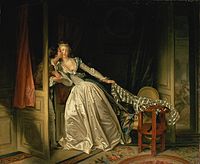Whatever you believe, a pattern that has printed on, or woven into, everything from Hermes silk scarves and ties to hippies' T-shirts and headbands originated many centuries ago, long before the first bicycle was built. What might paisley look like if its creator(s) got around on pedaled two-wheeled vehicles?
All right...So you never asked yourself that question. I confess: I never did, either. Somehow, though, I think I found an answer to it here:
 |
| From Bike Art: Bicycles In Art Around The World |
It's one of my favorite pieces of bicycle art I've seen in a while. Now I'll admit that I rarely see an image or representation of a bicycle that I dislike, even if it's of a bike I'd never ride or buy: bikes and cycling make me happy. Still, I realize that not all drawings, paintings or other objets that include or represent bicycles are art.
So what makes something art? (You weren't expecting to see a question like that on this blog, were you?) Well, as I understand it, art gets at the essence of something. A painter or sculptor will make a work about some particular person or subjects and render it from whatever materials he or she chooses or has available. But those people, subjects and materials are really just vehicles for expression of the forms--whether of light, texture, shape, sound or energy--within those subjects.
That is why something like the bull's head Picasso made from a bicycle saddle and pair of handlebars is, if not "high" art, then at least something more than mere amusement. To me, it represents the energy of moving forward on a bicycle and of the singular determination it sometimes takes to keep on riding, especially in adverse conditions.
So...Is the bike "paisley" a work of art? Maybe. Whatever it is, I think it went beyond--if only somewhat--typical stylized representations of bicycles. That's more than enough to make me happy.




























